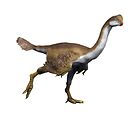Gurilynia
| Gurilynia Temporal range: Late Cretaceous,
| |
|---|---|
| Scientific classification | |
| Kingdom: | Animalia |
| Phylum: | Chordata |
| Clade: | Dinosauria |
| Clade: | Saurischia |
| Clade: | Theropoda |
| Clade: | Avialae |
| Clade: | †Enantiornithes |
| Genus: | †Gurilynia Kurochkin, 1999 |
| Species: | †G. nessovi
|
| Binomial name | |
| †Gurilynia nessovi Kurochkin, 1999
| |
Gurilynia is a genus of enantiornithine birds.[1] One species is known, G. nessovi. It lived during the Maastrichtian stage of the Late Cretaceous period, between 70 and 66 mya.[2] Gurilynia is known from fragmentary fossils found at the locality of the Nemegt Formation in south Gobi, Mongolia.
The fossil material includes three partial bones. The holotype is the proximal end of a right humerus, catalog number PIN 4499-12. A paratype is the distal end of a left humerus, catalog number PIN 4499-14. The last paratype is the shoulder end of a left coracoid, catalog number PIN 4499-13. All three fossils are in the collection of the Paleontological Institute of the Russian Academy of Sciences. The material is depicted in the journal with both photographs and illustrations. The humeral head is around 29mm wide. The largest enantiornithine from the Early Cretaceous is Pengornis, with a humeral head width of (17mm).[3]
Kurochkin also mentions that "The additional distal portions of the ulna, radius, and carpometacarpus from the same beds also very probably belong to the Enantiornithes." This passage may describe PIN 4499-1, which was later assigned to Teviornis. Kurochkin also adds that G. nessovi demonstrates that there were large Enantiornithids in Central Asia as well as the Americas at the end of the Cretaceous.[1]
References[]
- ^ a b Kurochkin, E.N. (1999) "A new large enantiornithid from the Late Cretaceous of Mongolia." In I. Darevskii and A. Averianov (editors), "Materials on the History of Fauna of Eurasia. Zoological Institute of the Russian Academy of Sciences, Saint-Petersburg" 277: 132–147. QL1 .A4253 v.277 1999[in Russian]
- ^ Clarke, Julia A., Norell, Mark A. (2004) "New Avialan Remains and a Review of the Late Cretaceous Nemegt Formation of Mongolia" "American Museum Novitates" Number 3447, 12pp. June 2, 2004
- ^ "Insight into diversity, body size and morphological evolution from the largest Early Cretaceous enantiornithine bird" Zhonghe Zhou, Julia Clarke, Fucheng Zhang "Journal of Anatomy" (2008) 212, pp565–577. doi:10.1111/j.1469-7580.2008.00880.x
- Late Cretaceous birds of Asia
- Euenantiornitheans
- Nemegt fauna















